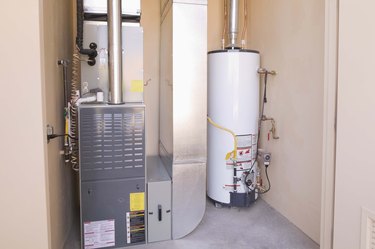Things You'll Need
Garden hose
Bucket

One of the methods used to heat homes is a hot water heating system. This type of system consists of running pipes that contain hot water from your boiler through the rest of your house. The heat is distributed through baseboards along the floor or radiators. As the water cools, it is returned to the boiler to be reheated. Occasionally, air will get into the heating system, which will cause noises such as bubbling or gurgling; if there's enough air, it could prevent the water from circulating throughout the house. You can fix this problem by bleeding your heating system.
Step 1
Shut your boiler off and record what the water pressure was.
Video of the Day
Step 2
Make sure that the self-feeding water valve is connected to the boiler so that water is available.
Step 3
Open up all the valves that go to the different heating zones in your home, then close all of the shutoff valves.
Step 4
Find one of the spigots that comes off the return line (this takes water back to your boiler to be reheated) and attach a short garden hose to the spigot.
Step 5
Open the self-feeding valve and the spigot, and let the water drain into the bucket or drain. Be very careful during this step--the water will probably be extremely hot.
Step 6
Let the water run out of the hose until you don't see any more air bubbles.
Step 7
Check to make sure that the water pressure doesn't go above 25 psi--if it does, release the self-feeding valve until the pressure drops below 25 psi.
Step 8
Once you don't see any more air bubbles in the water, release the self-feeding valve and close the spigot that the hose is attached to and let the water pressure to return to normal.
Step 9
Repeat this process for every zone until you have bled them all.
Step 10
Once you've finished bleeding every zone, close all of the zone valves and open all of the shutoff valves.
Step 11
Check the water pressure to make sure that it matches what it was before you bled the system, then turn the boiler back on.
Video of the Day